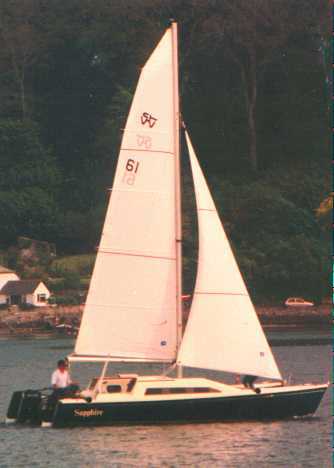Excerpted from Yachting World, October 1986
Short Test
Strider

A small, fast, cruising catamaran available in complete or kit form.
If you are interested in the speed of multihulls and yet want more than just a day sailer, there is a growing number of small multihulls around with minimal accommodation, permitting somewhat spartan weekending or coastal cruising.
One such is Strider, designed by Richard and Lillian Woods of Torpoint, Cornwall. She is a 24ft (7-3m) performance cruising catamaran which has enjoyed increasing popularity since 1983 when she was first marketed...
We sailed No 27 in a fresh southwesterly breeze between the Isle of Wight and the Lymington River and developed a taste for the fast life. The owner of this particular example is interested in performance rather than creature comforts, so both hulls are fairly well stripped-out.
The port hull is fitted with for-ward and after berths - the head end of each berth forms a seat when the accommodation is not in use. The standard design permits a hinge-up gas stove to be fitted against the outboard topsides, the cook sitting on the head of the forward berth.The area between the berths is the ‘saloon’ accommodation and here the headroom is 4ft 3in (1 -8m)There is some stowage beneath the forward berths, but the volume beneath the after berths is used as a pair of watertight compartments. Watertight compartments are provided forward and a self-draining deck locker in each bow provides convenient stowage for warps, fenders and ground tackle. .All the living accommodation is contained within the hulls. The area between the forward main beam and the headstay bridle or bow beam is covered with netting. Abaft this is a Terylene trampoline extending to the forward edge of the cockpit pan, which is a glassfibre moulding.
In standard form, Strider sets a mainsail with moderate roach and a fully battened head. A fully battened mainsail is available and this was carried on the yacht we sailed. The hulls are spaced by large diameter, aluminium alloy tubes set at the after end of the cockpit pan and ahead of the mast beam. In standard trim, the forestay is taken to a bridle set between the bows, but the yacht on test had a forward beam assembly fittedand this stiffens the yacht considerably. The beams are held in place to their respective hulls by stainless steel strap clamps so the boat can be disassembled for trailing. A purpose-built road trailer can be trailed behind a small family car.
It was the work of a moment to set the mainsail and, bare-headed, we beat down the Lymington river towards the open water of the Solent. Under this rig the cat was well-balanced and remarkably close-winded for her type. She pushed along at an eager 5.5 knots and tacked reliably. She maintained way through each tack and set off with alacrity. Although the south-westerly wind gusted across the deck at 16-18 knots, the cat kept both feet firmly in the water and remained docile and remarkably dry.…The helmsman sits on the deck area just abaft the accommodation access. Two people can sit here without overcrowding and they are afforded some protection when the spray starts flying by the after end of the raised house top. Although the tautly stretched trampoline was easy enough to move about upon and the raised house top of each hull created a pleasant feeling of security when working between them, the solid section of cockpit pan gives the cat almost a ‘big boat’. feel.
Lateral resistance is provided by a pair of hand-operated dagger boards, the cases of which are bonded against the inboard topside of each hull. This creates the minimum intrusion into the living space and allows each board to protrude from the top of each case alongside the edge of the trampoline where it is easy to reach. in the stiff breeze, the cat pushed to windward with enthusiasm, tacking through a commendable 80 degrees and requiring no help at all from a backed headsail to, throw her onto a new tack. Acceleration was excellent and on a close reach she immediately leaped into a 15-knot stride.
The ends of the hulls are nicely balanced, there was very little tendency for the lee bow to bury even when we ran into the back of a wave with a little extra puff up our tail and the motion was pleasantly devoid of the jerkiness so often associated with fast multihulls. We felt that relatively long coastal passages could be achieved in moderate weather without the crew being too tired by the motion.
In her most basic form, Strider is a fast, light and exhilarating day sailer, but there is shelter within the hulls should the weather turn inclement. It is also possible, however, to fit out the cat as a relatively comfortable little cruiser with cooker, chart table both foldaway, maybe - and a chemical toilet. A simple curtain across the hull would provide acceptable privacy.
The cat is a very able performer, strongly built and has an attractive outboard profile. She is great fun to sail and, in both complete and kit form, represents very good value for money.
A complete copy of this article can be obtained from Yachting World









